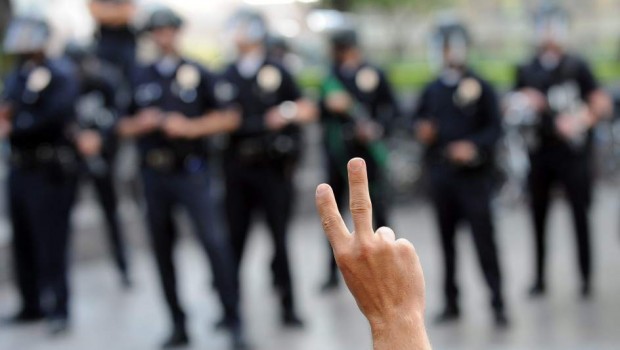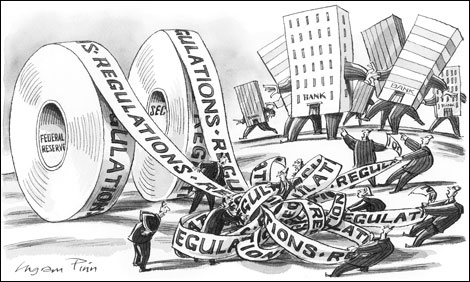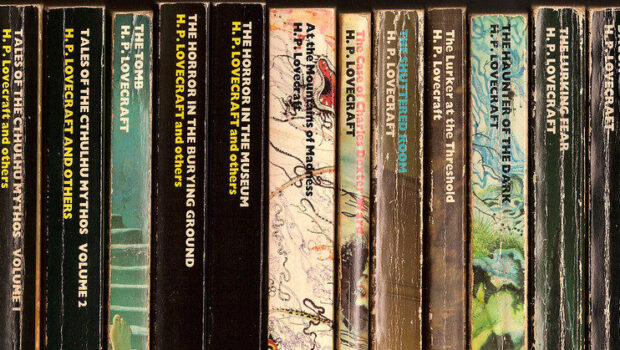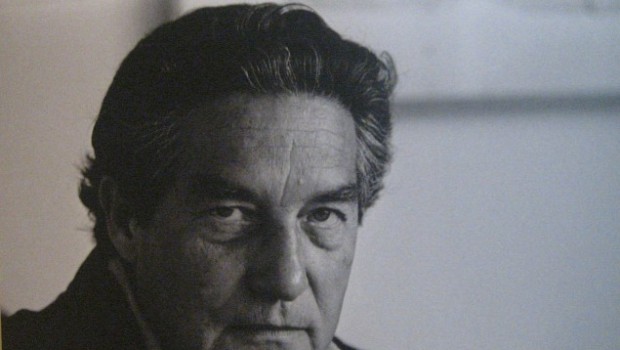15M and a (More or Less) Revolutionary Tradition
El 15M y la tradición (más o menos) revolucionaria
Ramón González Férriz
English translation by Tanya Huntington
The movement that physically and symbolically occupied Puerta del Sol on May 15, 2011 seemed to be a spontaneous outburst that had emerged at a particularly difficult time both politically and economically, but it was nothing new. Although it was now receiving media attention and a certain degree of understanding from the majority, it had existed for several decades. Its Spanish origins lay in the Libertarian movement of the 1970s and its international roots, in the more recent anti-globalization movement. The political goals of those who were camping out in the plaza had to do with: their denunciation of the illegitimacy of capitalist democracy, their call to reinvent society by way of a reinvention of individual awareness, and their belief in the possibility of establishing a new form of political organization based on a blend of anarchist and socialist recipes. The movement took years, if not decades, to organize itself in occupied homes that had been converted into cultural centers, neighborhood associations, and assembly groups. The media hardly ever took notice, except when they occupied a building or organized a theatrical protest for some specific purpose, because they were not politically relevant. Their particular modus operandi–their disdain for leader figures and hierarchy, their decision-making by unanimity rather than by majority, and their political language, distanced from the majority–prevented them from negotiating with democratic political powers, which they despised, and immersed them in a dynamic of ongoing internal debate that had scarcely any contact with the outside world. Their high level of organization allowed them, however, to sustain paper or Internet media communications, bookstores stocked with subversive literature, cultural activities such as concerts or workshops, and even a certain resonance in the academic world. But in general, they concentrated in certain neighborhoods, far removed from daily political disputes and immersed in their quest for revolutionary formulas and alternatives to the status quo that were sometimes rooted in regimes in the developing world, or in anti-capitalist economic concepts such as degrowth, organic agriculture, anarcho-feminism, or alternative spirituality. None of these ideas made much of an impact outside the splinter groups that backed them, although now and again some of their cultural traits–the hairstyle, the percussion music, the clothes, responsible consumerism, or fair trade–evolved into diluted trends within the mainstream and even found an echo in formations such as the United Left, which oscillated between classic socialism and alternative liberty, or unions fearful of losing their social base. But somehow, these alternative groups were organized as much as possible under their own guidelines in communities that aspired to self-rule.
True enough, many young people–and their elders as well–were now backing their vindications, fed up with the ineptitude of official politics, in order to satisfy what they considered to be their economic rights. But in general, the only true novelty was that this movement had experienced a media explosion. Their occupation of a major city square in the capital had given them a popularity and sympathy they had never before enjoyed. Suddenly, after May 15, political ideas such as assembly, self-rule or nationalization of the banks, all of them brandished in the shadows by these groups for years, were now on television. Journalists were taking them seriously, and they were being discussed by the media. Their provocative slogans and political projects, which had always gone unnoticed or had been taken as radical illusions, were introduced into the majority political debate. It mattered little whether their ideas were any good, or even possible: the protesters tended to argue from their campsite that they did not intend to create a coherent political program, but rather were expressing their unrest and conveying it to a public opinion that was enormously receptive to any expression of dissent with the status quo. The movement, now galvanized, aspired to surpassing traditional political articulations in the form of parties or labor unions, and therefore no one could demand its concretion, hierarchy, or systems of negotiation with institutions. Even though it had been in existence for decades, theirs was a new form of freer, better political participation, one that was more individualist and more communitarian at the same time.
However, while their forms of debate and their political ideas had descended from libertarianism and anti-globalization micro-movements, Real Democracy Now and the other groups around which the protestors were organizing and debating had incorporated the Internet into their vindicatory practices as a revolutionary element that provided the appearance of being strictly modern. In fact, one of the embryos of the massive protests on May 15th had been the organization via Internet of the #nolesvotes (don’t vote for them) campaign, launched in order to get out the vote in favor of any political group that–unlike the People’s Party, the Spanish Socialist Workers’ Party, and Convergence and Union–had not backed the passage of the so-called Sinde Law, which imposed legal restrictions on downloading pages, p2p, and links. The campaign had been promoted by successful Internet entrepreneurs and thinkers–such as Enrique Dans, Julio Alonso, Martín Varsavsky, and Ricardo Galli–who, once this movement joined the protesters, continued to lend their support despite the fact that the economic recipes they proposed clearly contradicted the calls for a greater liberalization of the Spanish economy that many of them had defended. That the power of articulation they had attributed to the Internet had transformed into a real movement in the streets doubtless provided strong backing for their ideas about 2.0 society and demonstrated the true political potential of their enterprises or seminars. And the fact that the political proposals of the movement were disjointed or contradicted theirs did not diminish that support. In fact, one of the most characteristic features of 15M was that even many citizens who were not in agreement with their causes supported their actions. Although their ends were wrong, they seemed to believe, their activities were a praiseworthy show of freshness and renewal, and meant that a generation that had been taken as indifferent or openly cynical with regards to politics was finally showing its ideals and energy for the struggle. Beyond a doubt, part of this positive vision was due to the lax nature of the movement’s proposals, and to the fact that it is hard to counter the desire to attain a more just society, a healthier economy, and a cleaner democracy. Also beyond a doubt, the state of the economy was so catastrophic and official policy seemed so incapable of doing anything about it that any heterodox initiative seemed to possess value in and of itself. But beyond all this, and beyond the fact that many observers believed they were seeing a new phenomenon when it was nothing more than a movement with decades behind it that suddenly had an impact in the media, there was something more.
Since the 1960s, liberal democracy has gradually expanded and gained strength in the West with unprecedented solidity. And it has been providing an ever-larger number of people with material dignity and liberties. Naturally, during this period all kinds of crises have occurred and models have been changed. In Spain, to be specific, these have cyclically repeated themselves since the advent of democracy, although it is possible that this crisis may be, indeed, singularly and especially destructive. Despite this, and despite its notorious failures, capitalism with liberties is the system preferred by a large margin of Westerners, and it is what has given them greater prosperity throughout history. However, during that same period, revolts have been never-ending. There have always been strong motives: in the 1960s, the moral and militaristic corsetry of society; in the 1970s, the disdain for minorities; in the 1980s in Spain, a prematurely aged and timid culture; in the 1990s, a globalization with great imbalances; and during the first decade of the 21st century, weariness as a result of an information monopoly sustained by major media industries and the economic crisis. These revolts had always failed politically–and that is one of the reasons why it is possible to state that capitalism is far stronger than in the past, when revolts sometimes did triumph–but they always left behind important cultural legacies, integrated into the system by the same generation that had created them, later to be transformed by those who followed. Capitalism not only seemed to withstand these revolts, in good measure it had transformed them into one of its motors, allowing it to mutate while continuing to be itself. The responsibility of maintaining this dynamic alive had successfully fallen to various generations of young people who, carried away by their hunger for change and their idealism, had to fight to invent a world tailored to their interests that would slowly expulse the cyclically aged representatives of an already anachronistic system.
Largely, this is what 15M–and also, for example, Occupy–meant and continue to mean, and a great deal of this is owed to sympathies that such movements have raised even among many who do not share their ideas. At certain moments, the selfsame act of rebelling may seem like a good idea, even though the possibilities of attaining victory are remote. Certainly many of the participants of the movement oscillate between the pride of belonging to an especially lucid minority and the belief that they are the true representatives of an entire people. Moreover, beyond the shadow of a doubt, they believe that they possess the ideological and tactical weapons necessary to become a truly active element of real politics. But beyond all of that, and beyond how they see themselves, these movements act for all of society as a sample of the possibility of rebellion, of confronting power no matter what the final result may be. Their innocence–something their members probably do not believe they possess–is that makes them pure and worthwhile in comparison with the cynicism of the powerful. Naturally, this implies a vast paternalism and, to a certain degree, ignores the rationalist idea that what is useful are those facts and ideas that succeed in transforming society for the better, not just good intentions. But in reality, all this sudden celebrity of a minority movement that had taken advantage of its long years of organization and discussion to put together a truly popular movement is no more than a consequence of the desire on the part of broad swathes of the middle class that are not even in synch with their ideas that something, anything, should happen in order to renew the hope of society through idealism. Once again, an indispensable optimism is required so that phenomena like these may even come to pass, but they are also a show of cyclic inertia: regularly trusting in movements that have demonstrated time and time again that they are not politically functional, but rather expressions of unrest that end up reduced, in the best case scenario, to cultural trends that, in the worst, if they are not capable of adapting to market mechanisms, must return to the shadows from whence they came.
El movimiento que el 15 de mayo de 2011 se apoderó simbólica y físicamente de la Puerta del Sol parecía un estallido espontáneo surgido en un momento de particulares dificultades económicas y políticas, pero era cualquier cosa menos nuevo. Aunque ahora recibiera atención mediática y un cierto grado de comprensión por parte de la mayoría, había existido desde hacía décadas, y tenía sus orígenes españoles en el movimiento libertario de los años setenta, y sus raíces internacionales en el más reciente movimiento antiglobalización. Los objetivos políticos de los acampados entroncaban con su denuncia de la ilegitimidad de la democracia capitalista, con su llamada a reinventar la sociedad previa reinvención de la conciencia de los individuos y con su creencia en la posibilidad de establecer una nueva forma de organización política basada en una mezcla de recetas anarquistas y estatalistas. El movimiento llevaba años, por no decir décadas, organizándose en casas ocupadas convertidas en centros culturales, en asociaciones de barrios, en grupos asamblearios. Los medios casi nunca les prestaban atención –excepto cuando ocupaban un edificio u organizaban una protesta teatral con algún fin concreto– porque no eran relevantes políticamente. Su propia forma de funcionamiento –su desdén por la figura del líder y la jerarquía, la toma de decisiones mediante la unanimidad y no la mayoría, su lenguaje político alejado del mayoritario– les impedía negociar con los poderes políticos democráticos, a los que despreciaban, y les sumía en una dinámica de eterna discusión interna que apenas tenía contacto con el exterior. Su alto nivel de organización les permitía, sin embargo, tener medios de comunicación en papel o en internet, librerías surtidas de literatura subversiva, actividades culturales como conciertos o talleres y hasta un cierto eco en la academia. Pero por lo general vivían concentrados en determinados barrios, ajenos a la disputa política cotidiana y sumidos en la búsqueda de fórmulas revolucionarias y alternativas al statu quo que a veces tenían sus raíces en regímenes del mundo en desarrollo, en ideas económicas anticapitalistas como el decrecimiento, la agricultura orgánica, el anarcofeminismo o la espiritualidad alternativa. Ninguna de estas ideas tenía demasiado eco fuera de los pequeños grupos que las respaldaban, aunque de vez en cuando alguno de sus rasgos culturales –el peinado, la música de percusión, la ropa, el consumo responsable o el comercio justo– llegaba a ser una tendencia diluida en el mainstream, e incluso hallaba eco en formaciones como Izquierda Unida, que oscilaba entre el estatalismo clásico y la libertad alternativa, o los sindicatos, temerosos de perder base social. Pero en cualquier caso, los grupos alternativos se organizaban en lo posible de acuerdo con sus reglas en comunidades que aspiraban a la autogestión.
Sin duda, muchos jóvenes –y mayores– se habían unido ahora a sus reivindicaciones hartos de la ineptitud de la política oficial para satisfacer lo que consideraban sus derechos económicos. Pero por lo general, la única verdadera novedad era que este movimiento había explotado mediáticamente. Su ocupación de una gran plaza en la capital le había dado una popularidad y unas simpatías de las que nunca había gozado. De repente, tras el 15 de mayo, ideas políticas como la asamblea, la autogestión o la nacionalización de la banca, todas ellas manejadas por estos grupos en la semipenumbra durante años, estaban en la televisión, los periodistas se las tomaban en serio y las discutían en sus medios. Sus lemas provocativos y sus proyectos políticos, que siempre habían pasado desapercibidos o habían sido tenidos por ilusiones radicales, eran introducidos en el debate político mayoritario. Poco importaba que sus ideas fueran buenas o siquiera posibles: los acampados solían argumentar que no pretendían hacer un programa político coherente, sino sólo expresar su malestar y trasladarlo a la opinión pública, y ésta era enormemente receptiva a cualquier expresión de disenso con el estado de las cosas. El movimiento ahora galvanizado aspiraba a ser una superación de las tradicionales articulaciones políticas en forma de partidos o sindicatos, y por lo tanto no podía esperarse de él su concreción, su jerarquía y sus sistemas de negociación con las instituciones. La suya, aunque llevara décadas existiendo, era una nueva forma de participación política más libre y mejor, más individualista y más comunitarista al mismo tiempo.
Sin embargo, si sus formas de discusión y sus ideas políticas eran descendientes del libertarismo y de los micromovimientos antiglobalizadores, Democracia Real Ya y los demás grupos alrededor de los cuales se organizaban y discutían, los manifestantes habían incorporado a su práctica reivindicativa internet, un elemento revolucionario que les daba una apariencia de estricta modernidad. De hecho, uno de los embriones de las protestas masivas del 15 de mayo había sido la organización en internet de la campaña #nolesvotes, destinada a pedir el voto a cualquier formación política que no hubiera apoyado –lo hicieron el PP, el PSOE y CiU– la aprobación de la llamada Ley Sinde, que ponía impedimentos legales a las páginas de descarga, p2p y enlaces. La campaña había sido promovida por exitosos pensadores y empresarios de internet –como Enrique Dans, Julio Alonso, Martín Varsavsky o Ricardo Galli– que, una vez que ese movimiento se sumó a las acampadas, siguieron dándole apoyo pese a que las recetas económicas que éste proponía iban claramente en contra de las llamadas a una mayor liberalización de la economía española que muchos de ellos habían defendido. Que el poder de articulación que le atribuían a internet se transformara en un movimiento real en las calles era sin duda un espaldarazo a sus ideas sobre la sociedad 2.0 y demostraba las verdaderas posibilidades políticas de sus empresas o sus lecciones. Y el hecho de que las propuestas políticas del movimiento fueran inconexas o contradijeran las suyas no impedía ese apoyo. De hecho, uno de los rasgos más característicos del 15M era que incluso muchos ciudadanos que no estaban de acuerdo con sus reivindicaciones apoyaban sus acciones. Aunque sus fines fueran equivocados, parecían creer, sus actividades eran una loable muestra de renovación y frescura, y significaban que una generación a la que se había tenido por indiferente o directamente cínica con respecto a la política, mostraba por fin ideales y energía para luchar. Sin duda, parte esta visión positiva se debía a la laxitud de las propuestas del movimiento y a que resulta difícil discrepar con el deseo de tener una sociedad más justa, una economía más sana y una democracia más limpia. Sin duda también, el estado de la economía era tan catastrófico, y la política oficial parecía tan incapaz de hacer nada al respecto, que cualquier iniciativa heterodoxa parecía tener valor en sí misma. Pero más allá de todo esto, y del hecho de que muchos observadores creyeran estar viendo un fenómeno nuevo cuando no era más que un movimiento con décadas a su espalda que de repente tenía eco mediático, había algo más.
Desde los años sesenta hasta hoy, en Occidente la democracia liberal se ha ido expandiendo y fortaleciendo con una firmeza inédita. Y ha ido dando a cada vez más personas dignidad material y libertades. Naturalmente, en este periodo se han sucedido toda clase de crisis y de cambios de modelo, y en España en concreto se han repetido cíclicamente desde la consecución de la democracia, aunque es posible que esta crisis sea, ciertamente, singular y particularmente destructiva. Pese a ello, y a sus notorios fallos, el capitalismo con libertades es el sistema predilecto, con mucha diferencia, de los occidentales, y el que les ha dado más prosperidad a lo largo de la historia. Sin embargo, durante ese mismo tiempo, las revueltas no se han detenido. Siempre han tenido buenos motivos: en los sesenta, el encorsetamiento moral y militarista de la sociedad; en los setenta, el desprecio a las minorías; en los ochenta españoles, una cultura envejecida y tímida; en los noventa, una globalización con grandes desequilibrios, y en la primera década del siglo XXI, el cansancio ante el monopolio de la información por parte de las grandes industrias mediáticas y la crisis económica. Las revueltas siempre habían fracasado políticamente –y ésa es una de las razones por las que cabe afirmar que el capitalismo es mucho más fuerte que en el pasado, cuando las revueltas a veces sí triunfaban–, pero siempre habían dejado tras de sí importantes legados culturales que la misma generación que los había creado integraba en el sistema y las siguientes volvían a transformar. El capitalismo no sólo parecía soportar esas revueltas, sino que en buena medida las había convertido en uno de sus motores para mutar sin dejar de ser él mismo. La responsabilidad de mantener viva esa dinámica había ido recayendo sucesivamente en las distintas generaciones de jóvenes, que, llevados por su ansia de cambio y su idealismo, debían pelear por inventar un mundo a su medida que fuera expulsando lentamente a los cíclicamente envejecidos representantes del ya anacrónico sistema.
En buena medida, eso significó y sigue significando el 15M –y también, por ejemplo, Occupy–, y a ello debe buena parte de las simpatías que ha suscitado incluso entre muchos que no comparten sus ideas. En determinados momentos, el hecho mismo de rebelarse parece bueno aunque las posibilidades de alcanzar la victoria sean remotas. Ciertamente, muchos de los participantes del movimiento oscilan entre el orgullo de pertenecer a una minoría especialmente lúcida y la creencia de que son verdaderos representantes de todo el pueblo. También, sin duda alguna, creen disponer de las armas ideológicas y tácticas para llegar a ser un elemento verdaderamente activo de la política real. Pero más allá de todo esto, y de cómo se vean a sí mismos, esos movimientos le sirven a toda la sociedad como una muestra de la posibilidad de rebelarse, de enfrentarse al poder, sea cual sea el resultado final. Es su inocencia –que probablemente sus miembros no crean tener– lo que les hace puros y valiosos frente al cinismo de los poderosos. Naturalmente, esto implica un inmenso paternalismo y, en cierta medida, ignora la idea racionalista de que lo útil son los hechos y las ideas que consiguen transformar la realidad para mejor, no las simples buenas intenciones. Pero en realidad toda esta celebridad súbita de un movimiento minoritario que había aprovechado sus largos años de organización y discusión para armar un verdadero movimiento popular no es más que la consecuencia del deseo por parte de amplias capas de la clase media que no sintonizan con sus ideas de que suceda algo, cualquier cosa, que renueve la esperanza de la sociedad en el idealismo. De nuevo, ahí está el optimismo imprescindible para que fenómenos como éste lleguen siquiera a producirse, pero es también una muestra de inercia cíclica: la de confiar regularmente en movimientos que demuestran una y otra vez que no son funcionales políticamente, sino sólo expresiones de malestar que acaban reducidas, en el mejor de los casos, a tendencias culturales que, en el peor, si no son capaces de adaptarse a los mecanismos del mercado, vuelven a la oscuridad.










